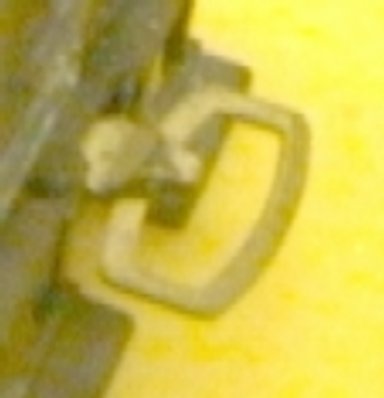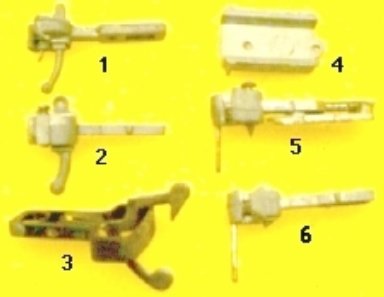Although automatic couplers had developed in tinplate earlier, practical applications in scale modelrailroading were slower in development.
In the late 40's, the debate was between operation and looks, since only dummies and some "almost works" looked decent and those that operated well did not remotely resemble the prototype. Designed by Eric LaNal (Allen Rice), Mantua's flat, rectangular loop and hook was by far the best operating, handling all of today's offset impossibilities with ease. Mounts were entirely different from all others, requiring major conversion surgery; when changing in either direction. Using the ubiquitous ramp, they required backward pushing to uncouple. Although they never really caught on, Kup-eze with smaller loops and larger hooks were introduced from Japan. Devore and MDC produced overscale prototypical knuckle couplers that almost worked. Among other problems, if during coupling, a knuckle closed by a frequent near miss; it had to be opened manually before the next try. To add to the fun during assembly, most of these had two coil centering springs, fore and aft and some required assembly of knuckles. All of these used a ramp to lift uncoupling pins. Some cast in draft gear boxes and the NMRA recommended add-on box were designed to accommodate these.


Mantua hook-loop coupler.
1. MDC first.
2. MDC second.
3. Kup-eze .
4. Kadee first box.
5. Kadee first.
6. Kadee k-4.
About 1952 KaDee, solved the coupling problem and introduced a crude hair-spring loaded lipless knuckle. Uncoupling was accomplished by spreading the vertical knuckle pins with a diamond shaped "ramp". The draft gear box was very unfriendly, requiring major surgery for mounting in most cases. A couple of years later the knuckle was refined, a side coil spring replaced the older one and the shank was made to fit existing boxes; creating the #4. Although still compatible, the older couplers were often referred to as "blobs". Globe introduced light weight plastic passenger car kits with glue-together sides, ends, roofs, floors and a dummy coupler with a large pivot ring. When Athearn acquired Globe and started plastic fabrication, they redesigned the cars with a one piece body and snap-in floor. they are still in production. Their plastic freight cars used the same coupler mount. Due to popularity, KaDee, introduced the #5 shank.
Shortly after long shank #6, short over set #7, and #5 long length #8 were added with the Globe type ring, shank end, for loco pilot mounting. The draft gear was .125" high and .125" OD with a small rectangular centering extension. A heavier 30 series type centering spring fit in a groove around inside of the base. The draft gear still fits where others will not, even with delayed action..
About 1955, the infamous X2F horn hook coupler was developed by an NMRA committee, headed by the would be expert, Paul Mallory, who has touted it for years to save face. These also required backward pushing for uncoupling. Although it was to be a the panacea, it flopped horribly among serious modellers. Along with a poor appearance, centering spring side thrust created more illnesses than were cured. The membership voted not to adopt it. Often referred to as a simile: "A camel is a horse designed by a committee." In spite of all its faults, including total incompatibility with existing couplers, due to cheap cost, most train set and many kit manufacturers replaced dummy couplers with them. Even though the NMRA rebuked them, many sellers referred to them as "NMRA couplers".
A major problem with the non-backup uncoupling varieties, was the requirement that ramps had to be lowered to avoid unwanted uncoupling. Draw strings and solenoids were used to raise them. About 1960, when Kadee introduced MK magnetic couplers to solve their problem , the knuckles were redesigned to an improved contour with a lip to reduce unwanted uncoupling and the uncoupling pins were replaced by the present "hoses", which pivot the knuckles.
Due to the popularity of Rivarossi cars and Central Valley trucks, 4 Talgo draw bars in the 500 series were developed by Kadee along with adapter boxes for their log cars.
About 1964, the MKD, delayed action series was introduced, requiring new springing. Knuckle springs were stiffened and centering springs were softened on the right side, to produce the swing required. As a result 6, 7 & 8 boxes were redesigned to larger size with two hair-springs. The right leg of the original heavier was hooked out of the way to permit delayed action swing toward lighter one. Over looked was the possibility that the same could be accomplished with the older box and it was dropped. New wider magnets were also required. Less popular magnetic horn hooks were introduced for a short period by Rail-Line and others.
Kadee expanded into other scales over the years. An N scale magnetic version was introduce around 1972 to compete with the standard Rapido, supplied with almost all equipment. The same coupler was used on the narrow gauge and old time couplers with only the uncoupling "hoses" modified. By this time Kadee had virtually cornered the entire market in semi-scale automatic couplers.
Somewhere along the way, AHM introduced the hybrid Mate-A-Matic 2000 "Universal Coupler", compatible with hornhooks and KaDee knuckles. The knuckle resembled a modified hornhook with a buffer extension below for pushing during delayed action. The shank was similar the Mc Keen #5. Since uncoupling magnets were at track side, hose orientation was different from KaDee's. The #5 type box had a large buffer extension across the bottom for use with none buffered knuckle types during pushing in delayed action operations. Coupling worked fairly well. Uncoupling and delayed action worked well among themselves. However with hornhooks uncoupling was not totally reliable and delayed action was absent for all practical purposes. By realigning hose angle, use with KaDee magnets and couplers was feasible and uncoupling was good. But even with one of the supplied box bottom buffers mounted on the KaDee box, pushing during delayed action was not fully acceptable. Overall they were noticeably superior to hornhooks, but definitely inferior to KaDees. Probably their best feature was use on conversion cars for testing, permitting engine swaps without changing loco couplers.
During this time, the 6, 7 and 8 were redesigned with new shanks and box, which reduced height at the expense of width. In addition to the width problem created, where the shank would not slide through many pocket openings; the lid was against the mounting surface on the vast majority of applications. This prevented assembly in place, thus requiring the hacking wide holes in many pilots. Kadee ignored requests to rectify the problem, which still exists.
Even though according to our sales and other reports, HO comprised over 82% of sales, Kadee #5 had more than triple the volume of all other couplers combined and N was less than 7%; many N conversion kits and adaptations were developed through to the 90's. While HO remained at a status quo with the same basic shank offerings developed over 40 years earlier.
About 1992, apparently Micro-Trains and all equipment, N and smaller, was divorced from Kadee. Some few HO adapters emerged for extraneous applications.
Due to expiration of patents, about 1996, competitors like McHenry, Accurail and Intermountain introduced new, almost compatible couplers. Prompted by the competition, Kadee developed the acetal 20 series with #5 shanks and various adapters for talgo trucks plus a few other applications. Gradually additional shaft lengths and knuckle offsets were added. Unfortunately for the serious modeller, the series has never been released in packs or bulk without all the extraneous adapters. Some competitors followed suit with some variations in shank lengths and styles.
About 1998, the original MKD 6, 7 & 8 box was re-introduced with the 20 series style shanks as the 30 series. Shortly following was the metal 40 series with 20 series shanks and #5 style boxes.
Early in 2000, almost scale knuckles were introduced. Most dimensions are very close, except the most important. The knuckle rear to pulling face distance is still too long for close prototype coupling. The prototype distance is 12", While all HO operating knuckle presently available exceed 17" and with operating clearance added exceed 19 1/2 " to produce over 39" between striking plates, where the prototype uses 30" on almost all freight cars, except those with cushioned draft gear. It is impossible to use 30" on any pair of cars without major surgery to allow part of the knuckle to recess under the end sill or striking plate. No magnetic, operating coupler in HO has earned the right to be called scale.
Unfortunately due to Kadee's distribution policies, many of the variations are scarce in hobby shops; since they not available through jobbers, thus requiring dealers to order directly from Kadee. The extra expenses, time and refill efforts discourage many dealers from carrying them. This also holds true for other items such as some trucks.
During 2001, McHenry and Bachmann introduced the much improved coil knuckle spring to the standard length and European style couplers; increasing competition and choice. Bowser and some other higher quality manufacturers are now including them with cars. Apparently, the hornhook is finally on its way out.
For more information on development of couplers, browse the US Patent Office Site and seach under "ccl/213/75tc". They are classified as "toy". Kadee's original 1951 "blob" is #74 on the present list. For the original 1941 Mantua enter "ccl/213/75tc and tyler"
BACK TO COUPLERS
BACK TO METHODS INDEX
